
Asterivora exocha is a species of moth in the family Choreutidae. It was first described by Edward Meyrick in 1907 and is endemic to New Zealand. This species has only been observed in the Humboldt Ranges of Otago and inhabits subalpine native bush at elevations of around 3600 ft. Adults of this species are on the wing in December and January and have been observed flying at dusk.

Asterivora iochondra is a species of moth in the family Choreutidae. It is endemic to New Zealand and was first described by Edward Meyrick in 1911. This species has been observed in both the North and South Island at Mount Holdsworth and Mount Arthur. This species inhabits open spaces on mountains on the forest edge at 3000 ft altitude. Adults of this species are on the wing in February and flies rapidly in sunshine.
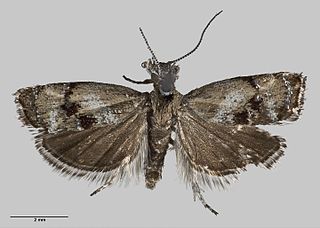
Asterivora urbana is a species of moth in the family Choreutidae. It is endemic to New Zealand and has been observed in Arthur's Pass. Adults are on the wing in January.

Heterocrossa contactella is a species of moth in the family Carposinidae. It is endemic to New Zealand and can be observed in both the North and South Islands. The preferred habitat of this species is native forest and scrub, especially where Leptospermum shrubs are found. Adults are on the wing in December and January.
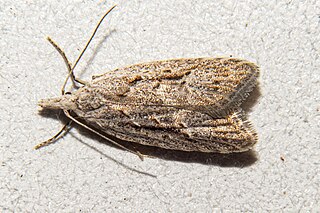
Heterocrossa cryodana is a species of moth in the family Carposinidae. It is endemic to New Zealand and is found in the southern parts of the South Island as well as at Codfish Island / Whenua Hou. This moth is associated with plants in the Leptospermum genus. Adults are on the wing from September until January.

Heterocrossa literata is a moth of the Carposinidae family first described by Alfred Philpott in 1930. It is endemic to New Zealand and has been observed the Franz Josef Glacier in subalpine habitat on the West Coast. Adults are on the wing in January.

Heterocrossa morbida is a moth of the Carposinidae family. It was described by Edward Meyrick in 1912 and is endemic to New Zealand. This species has been observed in both the North and South Islands. Adults are on the wing from August until February and are said to frequent clumps of Hoheria lyallii.

Heterocrossa sarcanthes is a moth of the Carposinidae family first described by Edward Meyrick in 1918. It is endemic to New Zealand and has been observed in Wellington. The adults of this species is similar in appearance to H. adreptella but can be distinguished from that species as H. sarcanthes has a pale pinkish-ochreous colour to the basal half of the hindwings.

Amblyptilia epotis is a moth of the family Pterophoridae. It is endemic to New Zealand and is found in the South and Stewart Islands. It inhabits mountainous terrain covered in alpine vegetation or alternatively alpine wetland habitat. The adults of this species are on the wing from February to March. In appearance the adults of this species are variable in colour however this species can be distinguished from similar species by the oblique apical streak on its forewings as well as the patch of white on the costa cilia towards the apex of the forewing.
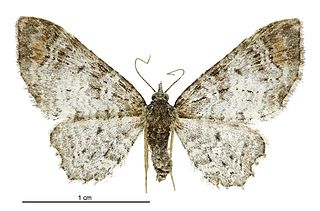
Pasiphila aristias is a species of moth in the family Geometridae. It was described by Edward Meyrick in 1897 and is endemic to New Zealand. This species is found in both the North and South Islands and inhabits subalpine and native forest. Adults are on the wing in December and January and are attracted to light.

Tingena eumenopa is a species of moth in the family Oecophoridae. It is endemic to New Zealand and found in the North and South Islands. The adults have been found amongst tree ferns and are on the wing in December.

Tingena letharga is a species of moth in the family Oecophoridae. It is endemic to New Zealand and has been observed in Otago. Adults are on the wing in December and January.
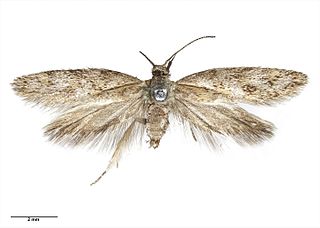
Tingena levicula is a species of moth in the family Oecophoridae. It is endemic to New Zealand.

Asaphodes prymnaea is a moth in the family Geometridae. It is endemic to New Zealand and can be found on the Mount Arthur tableland. It is common in limestone valleys. The female of the species is paler and has less distinctive markings than the male. Adults are on the wing in January and February.

Asaphodes sericodes is a moth in the family Geometridae. It is endemic to New Zealand and has been observed in the southern parts of the South Island. This species inhabits open tussock grasslands in subalpine scrub or wetlands. The female of the species is likely semi-apterous and is flightless. The adult males are on the wing in January.

Austrocidaria umbrosa is a species of moth of the family Geometridae. It endemic to New Zealand and has been observed in the South Island in Fiordland. Adults have been recorded as being on the wing in December, January and March. They are nocturnal and have been collected on and around Dracophyllum longifolium.
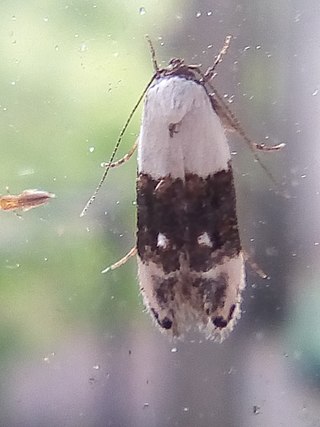
Trachypepla amphileuca is a species of moth in the family Oecophoridae. It is endemic to New Zealand and has been observed in the North Island. This species inhabits native forest. Adults are on the wing from October to January and are attracted to light. The wing pattern of T. amphileuca is said to imitate the appearance of bird droppings.

Atomotricha prospiciens is a moth in the family Oecophoridae first described by Edward Meyrick in 1924. It is endemic to New Zealand and has been observed in Fiordland and the Milford Sound. Adults of this species have been observed from October to December.
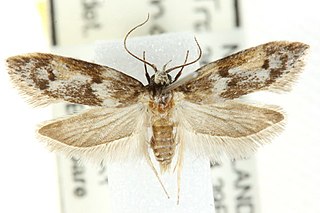
Trachypepla importuna is a moth of the family Oecophoridae and was first described by Edward Meyrick in 1927. This moth is thought to have been introduced to New Zealand, but is presumed to be native to Australia. T. importuna has been collected in both the North and South Islands of New Zealand. It inhabits native scrub and adults are on the wing in January and February. The placement of this species in the genus Trachypepla is regarded as unsatisfactory and in need of revision.

Orthenches dictyarcha is a moth of the family Plutellidae first described by Edward Meyrick in 1927. It is endemic to New Zealand and has been observed at Arthur's Pass and at Hollyford Valley in Fiordland. It is one of the larger species in its genus and is similar in appearance to O. homerica. Its preferred habitat is beech forest and adults are on the wing in January.





















